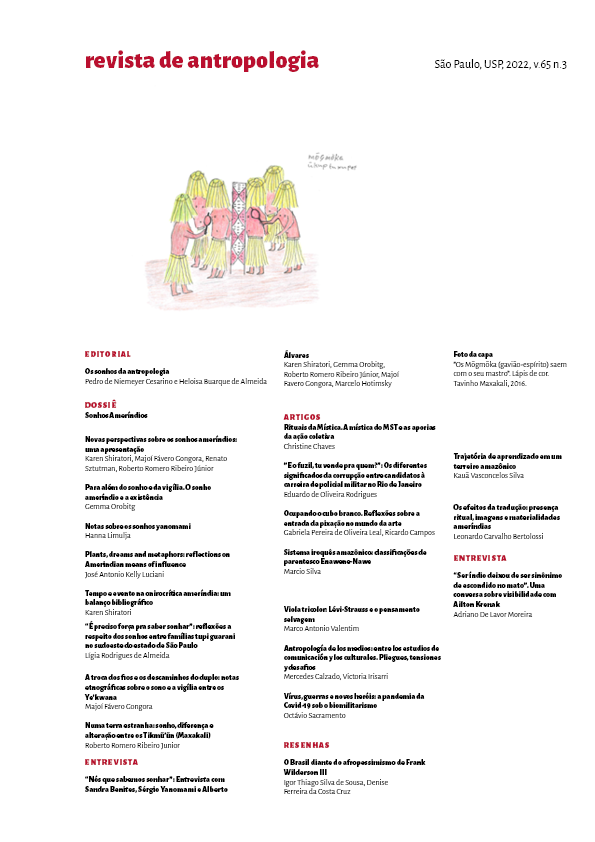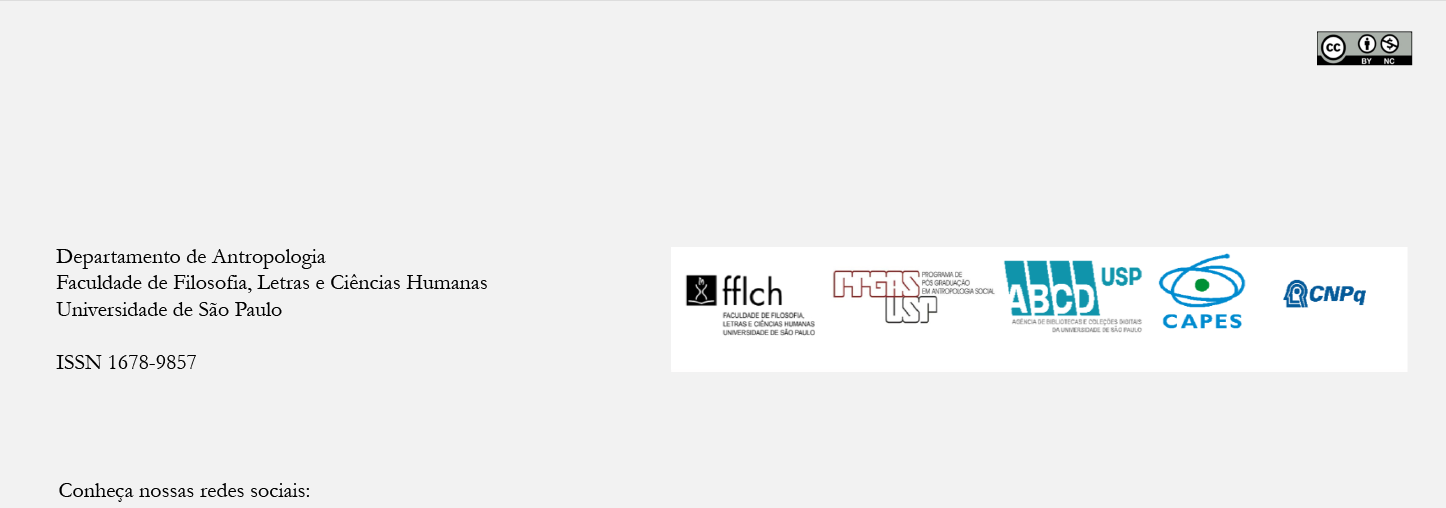Ocupando o cubo branco: reflexões sobre a entrada da pixação no mundo da arte
DOI:
https://doi.org/10.11606/1678-9857.ra.2022.197969Palabras clave:
Pixação, arte urbana, artificação, mundo da arte, São PauloResumen
Neste artigo descrevemos e analisamos a entrada da pixação no mundo da arte. Ao reconstituir situações que contribuíram com este trânsito, mostramos que o estigma e criminalização desta prática na esfera pública não impediram a sua gradual entrada em certos circuitos artísticos. Embora o processo de artificação da pixação envolva diferentes eventos e sujeitos, defendemos que ele resulta em grande medida de estratégias desencadeadas pelos próprios pixadores. Tal como ocupam as superfícies da cidade, eles e elas ocuparam o mundo da arte para fundar um lugar próprio. As reflexões apresentadas se baseiam em pesquisa sobre arte urbana realizada entre os anos de 2017 e 2021, que recorreu à análise de documentos e entrevistas em profundidade com um conjunto de atores sociais envolvidos neste contexto.
Descargas
Referencias
AUSTIN, Joe. 2001. Taking the train: how graffiti art became an urban crisis in New York City. New York, Columbia University Press.
BECKER, Howard. Art Worlds. Berkeley, Los Angeles and London, University of California Press.
BENGTSEN, Peter. 2014. The street art world. Lund, Almendros de Granada Press.
BOLETA (org.). 2006. Ttsss... A grande arte da pixação em São Paulo. São Paulo, Ed. do Bispo.
CAMPOS, Ricardo. 2021. “Urban Art in Lisbon: opportunities, tensions and paradoxes”. Cultural Trends, vol. 30, n.2: 139-155. DOI https://www.doi.org/10.1080/09548963.2021.1897779
CAMPOS, Ricardo; BARBIO, Leda. 2021. “Public strategies for the promotion of urban art. The Lisbon Metropolitan Area Case”. City and Community, vol. 20, n. 2: 121-140. DOI https://www.doi.org/10.1177%2F1535684121992350
CAMPOS, Ricardo; LEAL, Gabriela. 2021. “An Emerging Art World: the de-subculturalization and artification process of graffiti and pixação in Sao Paulo”. International Journal of Cultural Studies, 24(6): 974-992. https://doi.org/10.1177/13678779211018481
CAMPOS, Ricardo; SEQUEIRA, Ágata. 2018. “O mundo da arte urbana emergente: contextos e atores”. Todas as Artes. Revista Luso-Brasileira de Artes e Cultura, vol. 1, n. 2: 70-93. DOI https://www.doi.org/10.21747/21843805/tav1n2a4
CAMPOS, Ricardo; SEQUEIRA, Ágata. 2019. “Entre VHILS e os Jerónimos: Arte Urbana de Lisboa enquanto objecto turístico”. Horizontes Antropológicos, vol. 25, n. 55: 119-151. DOI https://www.doi.org/10.1590/S0104-71832019000300005
CASTLEMAN, Craig. 1982. Getting up: subway graffiti in New York. Cambridge, MIT Press.
CHASTANET, François. 2007. Pixação: São Paulo Signature. Paris, XGpress.
COHEN, Stanley. 2002. Folk Devils and Moral Panics: The creation of the Mods and Rockers. London and New York, Routledge.
COOPER, Martha; CHALFANT, Henry. 2016 [1984]. Subway art. London, Thames & Hudson.
CRESSWELL, Tim. 1992. “The Crucial ‘Where’ of Graffiti: A Geographical Analysis of Reactions to Graffiti in New York”. Environment and Planning D: Society and Space, vol. 10, n. 3: 329-344. DOI https://www.doi.org/10.1068%2Fd100329
DICKENS, Luke. 2010. “Pictures on walls? Producing, pricing and collecting the street art screen print”. City, vol. 14, n.1: 63–81. DOI https://www.doi.org/10.1080/13604810903525124
DIÓGENES, Glória. 2017. “Arte, Pixo e Política: dissenso, dissemelhança e desentendimento”. Revista Vazantes, vol. 1, n. 2: 115-134. Recuperado de http://periodicos.ufc.br/vazantes/article/view/20500
DIÓGENES, Glória; PEREIRA, Alexandre Barbosa. 2020. “Rasuras, ruídos e tensões no espaço público no Brasil: por onde anda a arte de rua brasileira?”. Dilemas - Revista de Estudos de Conflito e Controle Social, vol. 13, n.3:759-779. DOI https://www.doi.org/10.17648/dilemas.v13n3.25206
FERREL, Jeff. 1996. Crimes of Style: urban graffiti and the politics of criminality. Boston, Northeastern University Press.
FRANCO, Sergio. 2009. Iconografias da metrópole: grafiteiros e pixadores representando o contemporâneo. São Paulo, Dissertação de mestrado, Universidade de São Paulo.
GRONDEAU, Alexandre ;PONDAVEN, Florence. 2018. “Le street art, outil de valorisation territoriale et touristique: l’exemple de la Galeria de Arte Urbana de Lisbonne”. EchoGéon. 44. DOI https://www.doi.org/10.4000/echogeo.15324
GUINARD, Pauline; MARGIER, Antonin. 2017. “Art as a new urban norm: Between normalization of the City through art and normalization of art through the City in Montreal and Johannesburg”. Cities, n. 77: 13-20. DOI https://www.doi.org/10.1016/j.cities.2017.04.018
LACHMANN, Richard. 1988. “Graffiti as Career and Ideology”. American Journal of Sociology, vol. 94, n. 2: 229-250.
LASSALA, Gustavo. 2010. Pichação não é pixação. São Paulo, Altamira Editorial.
LASSALA, Gustavo. 2014. Em nome do pixo: a experiência social e estética do pichador e artista Djan Ivson. São Paulo, Tese de doutorado, Universidade Presbiteriana Mackenzie.
LEAL, Gabriela. 2018. Cidade: modos de ler, usar e se apropriar - Uma etnografia das práticas de graffiti de São Paulo. São Paulo, Dissertação de mestrado, Universidade de São Paulo.
MAUSS, Marcel. 2003. “As técnicas do corpo”. In: Sociologia e antropologia. São Paulo, Cosac e Naify, pp. 399-422.
MOLNÁR, Virág. 2018. “The business of urban coolness: Emerging markets for street art”. Poetics, n. 71: 43–54. DOI https://www.doi.org/10.1016/j.poetic.2018.09.006
PEREIRA, Alexandre Barbosa. 2018. Um rolê pela cidade de riscos: leituras da piXação em São Paulo. São Carlos, EDUFscar.
PIZZINATO, Adolfo; TEDESCO, Pedro de Castro; HAMANN, Cristiano. 2017. “Intervenções visuais urbanas: sensibilidade(s) em arte, grafite e pichação”. Psicologia & Sociedade, n.29: e169375. DOI https://www.doi.org/10.1590/1807-0310/2017v29169375
ROSS, Jeffrey Ian; BENGTSEN, Peter; LENNON, John F.; PHILLIPS, Susan; WILSON, Jacqueline Z. 2017. “In search of academic legitimacy: The current state of scholarship on graffiti and street art”. The Social Science Journal, n. 54: 411-419. DOI https://www.doi.org/10.1016/j.soscij.2017.08.004
ROSS, Jeffrey Ian; LENNON, John F.; KRAMER, Ronald. 2020. “Moving beyond Banksy and Fairey: Interrogating the cooptation and commodification of modern graffiti and street art”. Visual Inquiry, vol. 9, n.1-2: 5-23. DOI https://www.doi.org/10.1386/vi_00007_2
SCHACTER, Rafael. 2014. “The ugly truth: Street Art, Graffiti and the Creative City”. Art & the Public Sphere, vol. 3, n.2: 161–176. DOI https://www.doi.org/10.1386/aps.3.2.161_1
SHAPIRO, Roberta. 2004. “Qu’est-ce que l’artification?”. Congrès de l’AISLF, tours, juillet 2004 - comité de recherche 18 - sociologie de l’art - 2. https://halshs.archives-ouvertes.fr/halshs-00010486v2/file/Artific.pdf
SHAPIRO, Roberta. 2012. “Avant-Propos”. In: SHAPIRO, Roberta ; HEINICH, Nathalie (orgs.) De l’artification. Enquêtes sur le passage à l’art. Paris, EHESS, pp. 20-21.
SHAPIRO, Roberta. (2019) “Artification as Process”. Cultural Sociology, vol. 13, n. 3: 265-275. DOI https://www.doi.org/10.1177%2F1749975519854955
SHAPIRO, Roberta; HEINICH, Nathalie. 2012. “When is artification?”. Contemporary Aesthetics Special, n. 4. Disponível em http://hdl.handle.net/2027/spo.7523862.spec.409. Acesso em 14/05/2022.
VIEGAS, Glauce Cristine Ferreira Santos; SARAIVA, Luiz Alex Silva. 2015. “Discursos, práticas organizativas e pichação em belo horizonte”. RAM. Revista de Administração Mackenzie,vol. 16, n. 5: 68-94 DOI 10.1590/1678-69712015/administracao.v16n5p68-94
WACLAWEK, Anna. 2011. Graffiti and Street Art. London, Thames & Hudson.
WALDMAN, Thais. 2018. Entre batismos e degolas: a presença bandeirante em São Paulo. São Paulo, Teses de doutorado, Universidade de São Paulo.
WELLS, Maia Morgan. 2016. “Graffiti, street art, and the evolution of the art market”. In: ROSS, Jeffrey Ian (org.). Routledge Handbook of graffiti and street art. London & New York, Routledge, pp. 464-474.
YOUNG, Alison. 2014. Street art, Public City. London & New York, Routledge.
Descargas
Publicado
Número
Sección
Licencia
Derechos de autor 2022 Revista de Antropologia

Esta obra está bajo una licencia internacional Creative Commons Atribución 4.0.
Autores que publicam na Revista de Antropologia concordam com os seguintes termos:
a) Autores mantém os direitos autorais e concedem à revista o direito de primeira publicação, com o trabalho simultaneamente licenciado sob a Licença Creative Commons Attribution que permite o compartilhamento do trabalho com reconhecimento da autoria e publicação inicial nesta revista.
b) Autores têm autorização para assumir contratos adicionais separadamente, para distribuição não-exclusiva da versão do trabalho publicada nesta revista (ex.: publicar em repositório institucional ou como capítulo de livro), com reconhecimento de autoria e publicação inicial nesta revista.
c) Autores têm permissão e são estimulados a publicar e distribuir seu trabalho online (ex.: em repositórios institucionais ou na sua página pessoal) após o processo editorial, já que isso pode gerar alterações produtivas, bem como aumentar o impacto e a citação do trabalho publicado (Veja O Efeito do Acesso Livre).




